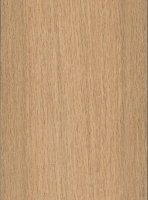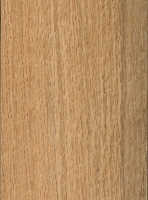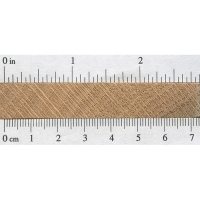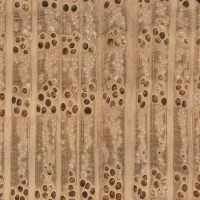 |
Common Name(s): Shumard Oak Scientific Name: Quercus shumardii Distribution: Southeastern United States Tree Size: 80-115 ft (25-35 m) tall, 3-5 ft (1-1.5 m) trunk diameter Average Dried Weight: 46 lbs/ft3 (730 kg/m3) Specific Gravity (Basic, 12% MC): .56, .73 Janka Hardness: 1,290 lbf (5,750 N)* *Estimated hardness based on specific gravity Modulus of Rupture: 17,830 lbf/in2 (123.0 MPa) Elastic Modulus: 2,154,000 lbf/in2 (14.86 GPa) Crushing Strength: No data available Shrinkage: No data available |
Color/Appearance: Heartwood is a light to medium brown, commonly with a reddish cast. Nearly white to light brown sapwood is not always sharply demarcated from the heartwood. Quartersawn sections display prominent ray fleck patterns. Conversely, White Oak tends to be slightly more olive-colored, but is by no means a reliable method of determining the type of oak.
Grain/Texture: Grain is straight, with a coarse, uneven texture. The pores are so large and open that it is said that a person can blow into one end of the wood, and air will come out the other end: provided that the grain runs straight enough. (See the video below.)
Endgrain: Ring-porous; 2-4 rows of large, exclusively solitary earlywood pores, numerous small latewood pores in radial arrangement; tyloses absent; growth rings distinct; rays large and visible without lens; apotracheal parenchyma diffuse-in-aggregates (short lines between rays).
Rot Resistance: Rated as non-durable to perishable, with poor insect resistance. Red Oaks do not have the level of decay and rot resistance that White Oaks possess.
Workability: Produces good results with hand and machine tools. Has moderately high shrinkage values, resulting in mediocre dimensional stability, especially in flatsawn boards. Can react with iron (particularly when wet) and cause staining and discoloration. Responds well to steam-bending. Glues, stains, and finishes well.
Odor: Has a tell-tale smell that is common to most oaks. Most find it appealing.
Allergies/Toxicity: Although severe reactions are quite uncommon, oak has been reported as a sensitizer. Usually most common reactions simply include eye and skin irritation, as well as asthma-like symptoms. See the articles Wood Allergies and Toxicity and Wood Dust Safety for more information.
Pricing/Availability: Abundant availability in a good range of widths and thicknesses, both as flatsawn and quartersawn lumber. Usually slightly less expensive than White Oak, prices are moderate for a domestic hardwood, though thicker planks or quartersawn boards are slightly more expensive.
Sustainability: This wood species is not listed in the CITES Appendices or on the IUCN Red List of Threatened Species.
Common Uses: Cabinetry, furniture, interior trim, flooring, and veneer.
Comments: Arguably the most popular hardwood in the United States, Red Oak is a ubiquitous sight in many homes. Even many vinyl/imitation wood surfaces are printed to look like Red Oak. Hard, strong, and moderately priced, Red Oak presents an exceptional value to woodworkers—which explains why it is so widely used in cabinet and furniture making.
- Black Oak (Quercus velutina)
- Bog Oak
- Brown Oak
- Bur Oak (Quercus macrocarpa)
- California Black Oak (Quercus kelloggii)
- Cherrybark Oak (Quercus pagoda)
- Chestnut Oak (Quercus prinus)
- English Oak (Quercus robur)
- Holm Oak (Quercus ilex)
- Japanese Oak (Quercus mongolica)
- Laurel Oak (Quercus laurifolia)
- Live Oak (Quercus virginiana)
- Oregon White Oak (Quercus garryana)
- Overcup Oak (Quercus lyrata)
- Pin Oak (Quercus palustris)
- Post Oak (Quercus stellata)
- Red Oak (Quercus rubra)
- Scarlet Oak (Quercus coccinea)
- Sessile Oak (Quercus petraea)
- Southern Red Oak (Quercus falcata)
- Swamp Chestnut Oak (Quercus michauxii)
- Swamp White Oak (Quercus bicolor)
- Turkey Oak (Quercus cerris)
- Water Oak (Quercus nigra)
- White Oak (Quercus alba)
- Willow Oak (Quercus phellos)
 |
 |
 |
 |




